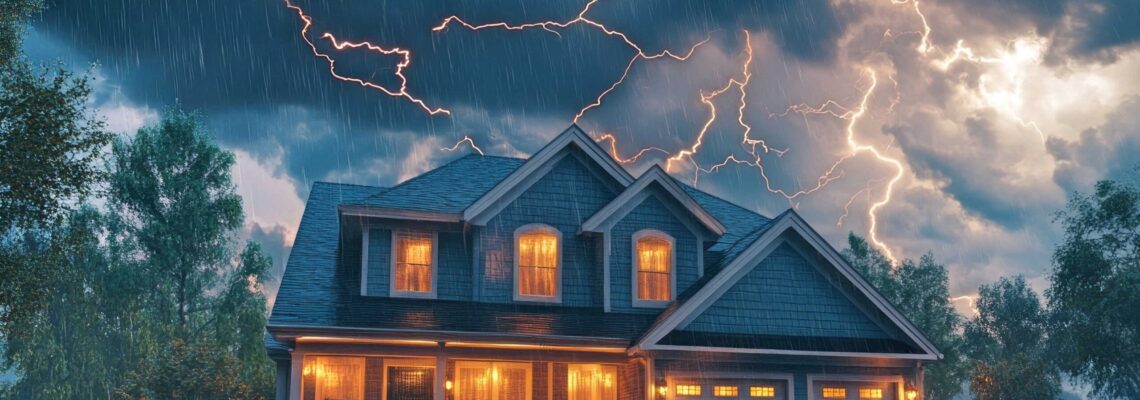When Spring storms hit, most of us mainly worry about flooding, but even with all that water, there is also an increased risk of fire damage.
Spring storms can leave behind hidden fire dangers, especially when it comes to your home’s electrical system.
Many homeowners mistakenly assume that the moisture from heavy rain reduces the risk of fires, thinking that the wet conditions would prevent ignition.
But this isn’t always the case. Spring storms often lead to conditions that significantly increase the likelihood of electrical fires, making vigilance and proper care essential after severe weather passes.
Why Storms Elevate Your Home’s Risk Of Fire Damage
Spring storms bring more than just heavy rain—they can also involve high winds, hail, lightning strikes, and flooding.
These elements often damage electrical lines, outlets, wiring, and other infrastructure critical to your home’s electrical safety.
Falling tree limbs or strong gusts can sever power lines or damage external wires, leading to dangerous electrical faults.
Lightning can cause immediate and severe power surges that travel through home wiring, damaging appliances, circuit breakers, or even hidden wires within your walls.
Flooding from heavy rains can infiltrate basements and crawlspaces, creating an environment where exposed wiring and moisture combine to significantly increase fire hazards.
Identifying Electrical Hazards After a Storm
After the skies clear, homeowners should carefully check for signs of electrical trouble in and around their home.
Pay close attention to flickering lights, tripping circuit breakers, and outlets or switches that produce sparks, buzzing sounds, or burning smells.
These are indicators that something within the electrical system may have been compromised during the storm.
Additionally, water pooling near electrical outlets or panels can pose serious risks.
While visual inspections are valuable, homeowners should avoid touching or closely inspecting electrical systems that appear damaged or wet to prevent serious injury.
Essential Safety Steps Following Storm Damage
Following any major Spring storm, ensuring the immediate safety of your family is critical.
One essential action is turning off the electricity in flooded or severely damaged areas, provided it can be done safely at your home’s circuit breaker or fuse box.
If the panel itself is wet or damaged, stay away and call an electrician immediately.
Never attempt to handle electrical equipment while standing in water, and be cautious of downed power lines near your home—treat them as live and dangerous at all times.
It’s also advisable to unplug major appliances if you suspect electrical surges or damage has occurred, reducing the risk of subsequent fires or appliance failure.
The Hidden Dangers of Moisture and Electricity
Moisture creates a particularly hazardous environment for electricity because water is a conductor that can cause shorts, overheating, and fire damage.
Even minimal moisture intrusion from leaks, flooding, or condensation can degrade insulation around electrical wiring.
When insulation becomes compromised, wires can spark or arc, quickly igniting nearby combustible materials within walls, ceilings, or floors.
Over time, even small amounts of moisture trapped inside wall cavities or behind outlets can foster corrosion, increasing resistance and heat buildup.
This dangerous combination sets the stage for potentially devastating electrical fires.
The Critical Importance of Professional Electrical Inspections
Given the complexities and hidden dangers involved, a professional electrical inspection following a significant Spring storm is strongly recommended.
Qualified electricians can thoroughly inspect wiring, outlets, circuit breakers, and electrical panels, identifying hazards invisible to the untrained eye.
They’ll safely evaluate areas impacted by moisture, inspect for fire hazards caused by power surges, and repair or replace any damaged components.
A proactive inspection not only ensures safety but also prevents small problems from developing into dangerous fire hazards.
Implementing Long-Term Fire Prevention Measures
Reducing future risks is a crucial step after storm-related electrical damage. Homeowners should consider investing in whole-house surge protectors, which guard appliances and internal wiring from sudden voltage spikes caused by lightning or power surges.
Installing Ground-Fault Circuit Interrupters (GFCIs) in wet or damp areas, such as bathrooms, kitchens, basements, and outdoor spaces, further reduces fire hazards by cutting power instantly when detecting abnormal electrical flows.
Regularly trimming trees and branches around power lines and outdoor wiring is another preventive measure that reduces the risk of storm-induced fire damage.
PuroClean Certified Restoration Is Here To Help
If your home does experience an electrical fire following a Spring storm, the importance of hiring a professional fire damage remediation company cannot be overstated.
Our professionals possess the training, specialized equipment, and expertise required to handle complex electrical fire cleanup and restoration safely.
We can quickly assess the extent of both visible and hidden damage, remediate smoke and soot contamination, and ensure structural integrity is properly restored.
Professional fire damage remediation helps prevent secondary issues such as mold growth, corrosion, or lingering smoke odors.
Our comprehensive approach ensures your home is not just clean, but safe for your family’s long-term peace of mind.
If you ever need help with electrical fire damage restoration after a Spring storm, call the professionals at PuroClean Certified Restoration. We’ll make sure the job is done right.


